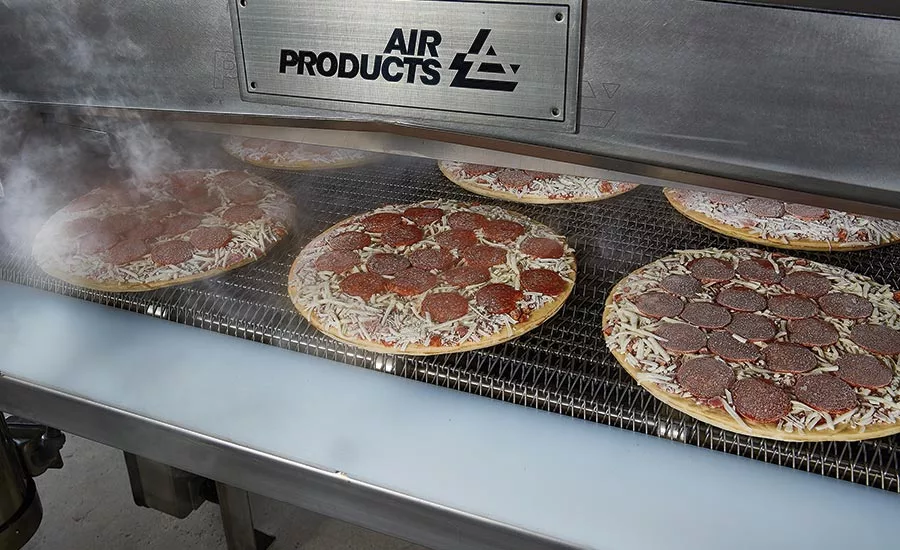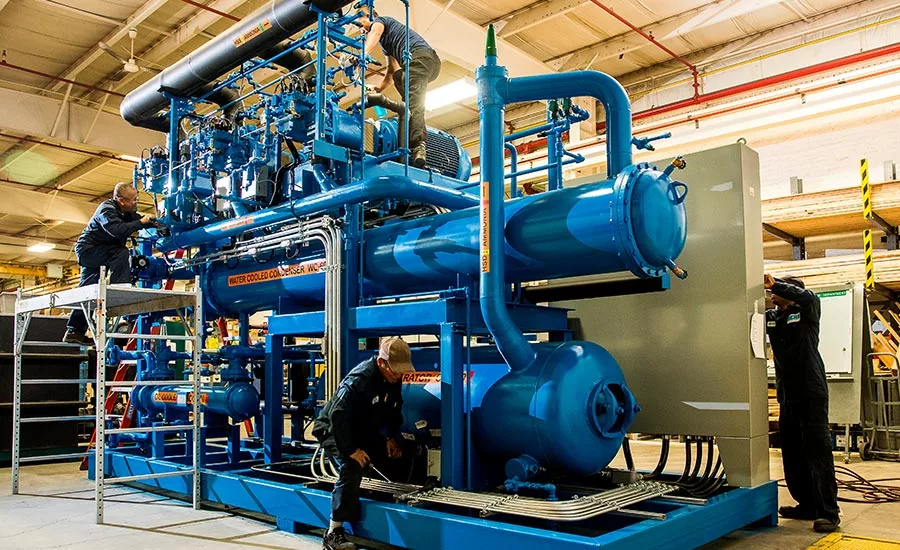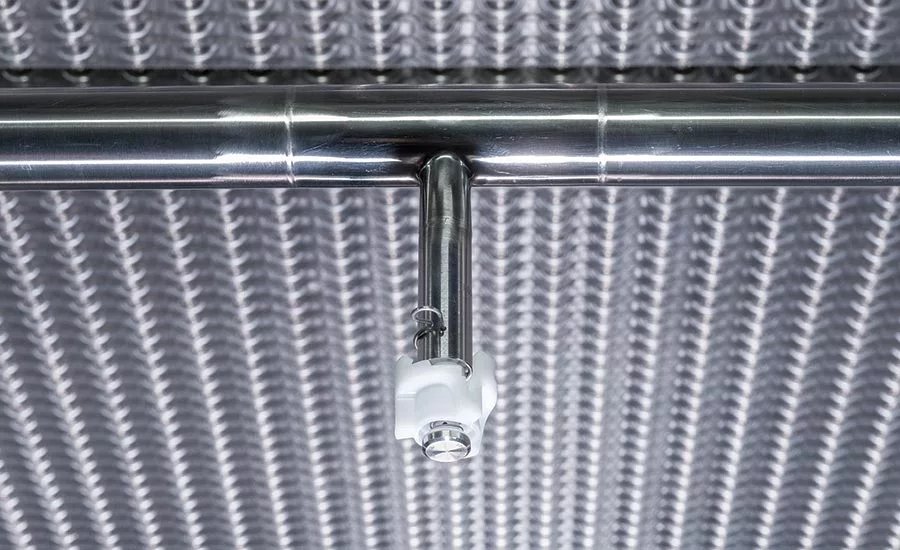Tech Update
How strong is your weakest link in the cold food chain?

Air Products’ Freshline IQ tunnel freezer comes in 10-ft. modules and expands easily as production needs grow. It is equipped with technology that enables users to review historic data to troubleshoot, track efficiency and ensure the required temperatures are maintained.
Photo courtesy of Air Products

Workers putting finishing touches on a factory-assembled ammonia refrigeration package for a cooling tunnel addition by Berg Chilling Systems at a dairy processing facility.
Photo courtesy of Berg Chilling Systems

Automation in the cleaning process is important to help ensure consistency and repeatability.
Photo courtesy of FPS

Clean-in-place systems in the freezer allow hard- to-reach spots to be cleaned during the freezing process.
Photo courtesy of FPS
Most consumers don’t give a second thought to how their cold food reaches their homes. They rely on companies to do their due diligence, which offers peace of mind, brand loyalty and a healthy population.
Many foodborne illnesses occur because a link in the cold food chain was weak or broken, with temperature inconsistencies that allowed pathogens to begin growing. By the time the food hits the consumer’s fork, it is too late. By utilizing freezing and chilling equipment throughout all stages of the process, food and beverage processors, material handlers and transporters can ensure that the end product is safe for consumption. Additionally, foods and beverages that have been handled and stored at the right temperature will taste better. It’s a win-win.
According to FDA’s Hazard Analysis and Risk-Based Preventive Controls for Human Food: Draft Guidance for Industry, Chapter 4.3.2, temperature is an essential factor that affects the growth of bacteria, which can occur over a wide range of temperatures from about 23°F (-5°C) to 194°F (90°C). The table below lists four types of bacteria based on their temperature growth ranges.
Thermophiles grow at hot temperatures above 131°F (55°C). Mesophiles grow at or near room temperatures. Psychrophiles grow at or near refrigeration temperatures. Psychrotrophs are capable of growth at refrigeration temperatures, but their optimal growth temperature is in the mesophilic range. Most pathogenic bacteria are mesophiles, and their optimum growth temperature corresponds to human body temperature. Typically, the higher the temperature (within the normal growth range), the more rapid the growth of the microorganism.
The guidance also points out that total time of exposure to temperatures that allow growth needs to be controlled. The most general recommendation is to hold cold foods below 41°F (5°C) and to keep hot foods above 135°F (57°C).
Armed with this information, every part of the cold food chain needs to be vigilant about keeping foods at safe temperatures.
“Refrigeration is an important contributor to the safe preservation of food and beverage products, and for some producers, it plays a crucial role in production,” says Evis Buli, sales engineer at Berg Chilling Systems, which provides industrial refrigeration and temperature control systems to the food and beverage sector, including cooling and chilling/freezing.
Looking for quick answers on food safety topics?
Try Ask FSM, our new smart AI search tool.
Ask FSM →
“Breweries, for example, require constant temperatures in their cooling process to properly adhere to a recipe. Missing or not being able to hold a required temperature setpoint can result in poor product quality or having to scrap an entire batch of beer.” He notes that other processes, such as carcass cooling, have strict requirements in pull-down temperatures and times between critical points. “It is important that the refrigeration systems are sized properly, are custom tailored to match process needs, and are intelligent,” Buli says.
Scott Robertson, industry manager for foods, Americas, at Air Products, says that the company supplies cryogenic food-grade gases (nitrogen and carbon dioxide) and equipment that enables food processors to freeze and chill product in minutes versus the hours required with traditional systems. “This rapid freeze results in safer, higher-quality food products,” he says.
He adds that cryogenic freezers are very simple to operate and maintain. “They are also easy to clean and inspect because there are no refrigeration coils or other nooks and crannies associated with mechanical systems,” he says. This simplicity of design means the equipment can be cleaned faster and more effectively. Equally as important, the simple design means the equipment can be easily inspected after sanitation to ensure it has been cleaned properly.
Robertson says that one of the key areas where food processors rely on nitrogen or CO2 is to chill or freeze their products faster. Liquid nitrogen is -320°F and CO2 snow is -109°F. Although nitrogen or CO2 systems are rarely operated at temperatures this cold, both gases have a tremendous driving force to chill or freeze food products quickly and effectively.
“Not only can we help food processors looking to install new processing lines, but we can also help food processors address issues with their current lines,” says Robertson.
“With the increased focus on food safety, food processors are often looking to us for solutions to supplement their current chilling or freezing systems with cryogenics. Since cryogenic freezing and chilling solutions do not take up much space, we can often retrofit our systems into existing floor space to help processors achieve their target product temperatures faster. We also can increase throughput with existing processing lines.”
He says that another item to note is that Air Products’ food grade gases comply with, and often exceed, relevant national requirements for food quality, hygiene, traceability and specifications.
“We maintain a strict protocol of internally and externally audited management systems to guarantee this to our customers. Our food grade gases also meet food safety requirements using HACCP (Hazard Analysis Critical Control Point) principles for accessing the production and distribution processes.”
To help Berg’s customers adhere to safe food handling requirements, Buli says the company designs its food and beverage refrigeration systems with the standards and regulations at top of mind.
“We ensure that there are layers of safety designed in the system, such as using food-grade secondary coolants, double-wall heat exchangers, and proper design on the pressure difference between the food side and the coolant side to prevent contamination,” he says. “We then implement preventative maintenance programs that ensure the refrigeration system always operates within its design parameters. A good refrigeration system preventative maintenance program helps food processors maintain product quality, ensuring customer satisfaction and profitability.”
Smart is cool
“Today’s refrigeration systems are smart,” says Buli. The most significant recent advancement in the food industry is in system control. “Controls hardware is becoming more affordable than ever, and there is a need from food and beverage processors for better system monitoring and feedback,” he continues. “In addition to being highly efficient, [today’s refrigeration systems] provide real-time feedback on the processes and can be proactive in implementing beneficial corrections to ensure consistent product quality. They are designed to handle many monitoring points and provide the operators accessibility to the process.”
Robertson adds that simplicity of design and modularity are also important aspects of today’s models.
Justin Lai, vice president of sales and marketing at Food Process Systems, says that automation in the cleaning process is also important to help ensure consistency and repeatability. “Adding clean-in-place systems to the freezer is a significant step as the freezing equipment is typically the largest piece of equipment in the production line with many hard-to-reach spots. Furthermore, control of air flow at the infeed and discharge is critical as condensation can develop at the boundaries between hot and cold areas,” he says.
Buli adds that IIoT and automation have a huge effect on the cold food chain. “These control systems help reduce waste, maintain process and product consistency, increase production yield, monitor equipment, and prompt preventative maintenance actions before problems occur. The last thing food processors want is an unexpected upset that costs them a batch of product, and IIoT can help them see problems before they happen.”
System control technology is getting more and more advanced, Buli says.
“We break the cooling curve into multiple segments that can be customized and adjusted for different products,” says Buli. “After finding the ideal positions within these parameters, we make sure to minimize the pull-down time without compromising the yield of the product being cooled. Different products have different cooling curves that apply to them.”
Robertson agrees. “Our food customers are becoming increasingly data driven and are looking for increased visibility into how our equipment operates,” he says. “The Air Products Process Intelligence offering enables our customers to review historic data to troubleshoot, track efficiency and ensure the required temperatures are maintained in their food processing equipment.”
For instance, Air Products recently introduced its Freshline IQ tunnel freezer. “This freezer comes in 10-ft. modules and is very simple to expand as our customers’ production needs grow,” Robertson says.
Robertson says there has been an increased interest from food processors in chilling their sauces and liquids more rapidly. The company’s technology enables customers to chill sauces and liquids in one of two ways. The chiller injects cryogen into sauces or liquids as they are pumped, which enables sauces to be chilled rapidly and efficiently in minimal floor space. Or a new technology enables cryogen to be injected directly into existing kettles or vessels.
“This gives our customers another option to chill their sauces in existing equipment, where their existing mechanical system is not able to achieve the desired results,” Robertson says.
Lai says that the latest technology at FPS is its spiral immersion system (SIS). The spiral conveyor is in a tank of liquid—usually water or brine.
“Different from our iconic spiral freezer, SIS uses liquid as the medium to freeze food products while the spiral freezer uses air,” he says. SIS is designed to process anything that is bagged or comes with a natural casing, rind, skin or shell, such as soups, sauces, crab and shellfish.
“SIS freezes the surface of the food faster because heat is transferred 25 times faster in water than in air. The faster the products freeze, the smaller the crystals, which results in less cellular disruption, and the products retain better color, texture, flavor and nutrition,” Lai explains. “This technology is not only a food processing platform for food freezing, but it is also a platform for pasteurizing, cooking and chemically treating.”
Proactive processors
There are steps that food and beverage processing companies can take to ensure quality and safe product in the cold food arena. For instance, Buli says that food processing companies will benefit by engaging an experienced refrigeration vendor early in the planning process to collaborate on a well-defined strategy for the project.
“Bringing a refrigeration expert in on the ground floor will help to identify the exact specifications and overall goals and will ensure the system provided will strike the right balance between performance, energy efficiency and proper operation, while providing optimal return on investment,” he says. “Food processors need to be proactive with their preventative maintenance programs to reduce the risk of downtime, costly spoilage and financial loss.”
Robertson says that the first step to ensure product quality and safety is to determine the feasibility of chilling and freezing with cryogenic food-grade gases (nitrogen and CO2). Lai adds that mechanical CO2 refrigeration systems in lieu of Freon and ammonia mechanical refrigeration system can help facilities operate efficiently at lower temperatures.
Another trend worth noting is the use of CO2 snow or pellets to maintain product temperatures through the supply chain, Robertson says. Although the use of CO2 in this application is nothing new, food processors are looking for technologies that improve efficiency and reliability.
“For example, many customers have traditionally had dry ice pellets or blocks delivered to their facility from a local distributor. This can be expensive and require a lot of space to store totes of dry ice,” he says. “Increasingly, our customers are looking to generate their own dry ice on site.”
Let consumers chill
Knowing the right temperatures for your cold food and beverages and maintaining them out of the “danger zone” are important for safe and quality end products. Reliable, smart equipment can help food and beverage processors, as well as handlers and transporters, keep consumers’ minds at peace and their bodies free from foodborne temperature-related pathogens.
Sidebar: Cool innovation at R&D test kitchen >>
For more information:
Berg Chilling Systems, www.berg-group.com
Air Products, www.airproducts.com
Food Process Systems Inc., www.fpsinc.net
Sara Lee Frozen Bakery, www.saraleefrozenbakery.com









